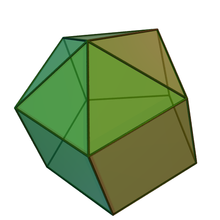| Elongated pyramid | |
|---|---|
 Example: pentagonal form | |
| Faces | n triangles n squares 1 n-gon |
| Edges | 4n |
| Vertices | 2n + 1 |
| Symmetry group | Cnv, [n], (*nn) |
| Rotation group | Cn, [n]+, (nn) |
| Dual polyhedron | self-dual |
| Properties | convex |
In geometry, the elongated pyramids are an infinite set of polyhedra, constructed by adjoining an n-gonal pyramid to an n-gonal prism. Along with the set of pyramids, these figures are topologically self-dual.
Contents
There are three elongated pyramids that are Johnson solids:
- Elongated triangular pyramid (J7),
- Elongated square pyramid (J8), and
- Elongated pentagonal pyramid (J9).
Higher forms can be constructed with isosceles triangles.


